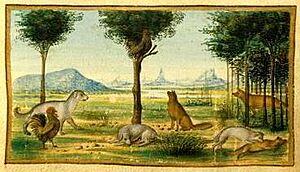The Cock, the Dog and the Fox facts for kids
The Cock, the Dog and the Fox is a famous story from Aesop's Fables. It's about a clever rooster who outsmarts a tricky fox. Unlike some other fables where a bird gets tricked, in this one, the rooster is the winner! There are also similar versions of this story from places like India.
Contents
Different Versions of the Story
This fable has been told in many ways over hundreds of years. Each version might have small differences, but the main idea stays the same.
The Greek Story
In the original Greek version, a rooster and a dog travel together. At night, the rooster sleeps in a tree. The dog curls up at the bottom of the tree. When the rooster crows in the morning, a fox hears it. The fox comes over and tries to be friendly. It wants to trick the rooster into coming down.
The rooster is smart. He agrees to come down, but tells the fox to ask the "porter" to open the door first. The fox, confused, bumps into the sleeping dog. The dog wakes up and attacks the fox, saving the rooster.
Eastern Tales
An old Indian version of this story is found in Buddhist writings. It's called the Kukuta-Jataka. In this tale, a hungry cat has already eaten many other birds. It tries to trick a rooster by promising to marry him. But the rooster is too wise. He knows the cat's bad history and refuses to be fooled.
This Indian story traveled west and became part of The Thousand and One Nights. In this version, the fox tries to trick the rooster by saying that all animals are now friends. The rooster pretends to believe the fox. He then says he sees dogs running towards them. He claims they must be messengers of this new peace. The fox gets scared and runs away. The rooster then asks why the fox is leaving. The fox replies that maybe the dogs haven't heard about the peace yet!
European Retellings
The Eastern version of the story became very popular in Europe. It appeared in a book of funny tales by Poggio Bracciolini in 1450. Later, in France, Guillaume Gueroult told the story in 1550. He added that the rooster made up the story about the dogs because he didn't trust the fox. Gueroult's version ended with a saying: "To the trickster comes a trickster and a half."
Jean de la Fontaine also retold this story in his famous fables. He called it Le coq et le renard (The Cock and the Fox). He ended his story with a similar message: "It's double the pleasure to trick the trickster."
Blending the Stories
Over time, the Greek and Eastern versions of the fable sometimes got mixed up. For example, in an illustrated book of fables from 1687, the English poem told the Eastern version. But the Latin summary next to it followed the Greek story.
Much later, in 1990, a French artist updated La Fontaine's fables for TV. For this story, he chose to use the Greek version. He made the rooster a jazz singer and the dog his protective bouncer!


